The Shenyang J-8 is a single-seat, twin-engine interceptor fighter that first entered development in 1965, though the aircraft did not enter operational service until the early 1980s. Over the years, the aircraft continued to evolve with new sensors and weapons added to improve its capabilities. This process continued until the late 2000s, when it was finally succeeded by a new generation of fighter aircraft such as the J-10 and J-11.
J-8 ‘Finback-A’
In the late 1950s, the Western countries began to develop their next-generation nuclear-armed, deep-penetration strategic bombers and reconnaissance aircraft with performance far exceeding that of even the most capable fighter in service with the PLAAF. As a result, the Chinese military required a new high-performance interceptor fighter that could fly at a maximum speed of Mach 2.2, reach a service ceiling of over 20,000 m, achieve a sea-level climb rate of 200 m/s, and reach a combat radius of 750 to 1,000 km. The fighter was also required to be capable of intercepting enemy targets using radar-homing medium-range air-to-air missiles (MRAAM).
In May 1964, the Sixth Academy of the Ministry of National Defence began the theoretical evaluation of the new fighter aircraft. The programme definition published in October 1964 described a high-performance fighter capable of intercepting the U.S. Convair B-58 Hustler bomber and the Republic F-105 Thunderchief fighter-bomber. In response, the Shenyang Aircraft Design Institute (601 Institute) proposed an enlarged twin-engine turbojet-powered version of the J-7 (Chinese copy of the MiG-21F ‘Fishbed’), known as J-8, while the Chengdu Aircraft Design Institute (611 Institute) proposed a single-engine, turbofan-powered, canard-delta layout fighter named J-9. The J-8 concept was eventually chosen by the PLA in 1965, while the J-9 concept later evolved into the Chengdu J-10 fighter in the 1980s.
The J-8 entered the engineering development in September 1965, with a mock-up produced for inspection in December. The Shenyang Aircraft Factory (now SAC) began the prototype production in 1966. The first two J-8 prototypes rolled out in July 1968, and the first flight of the aircraft took place on 5 July 1969. However, the J-8 development was seriously interrupted by the ‘Cultural Revolution’ in the late 1960s and early 1970s. The flight testing of the aircraft was not completed until December 1979, ten years after the aircraft’s maiden flight. The J-8 was finally certified for design finalisation in December 1979 and entered service with the PLAAF in 1981.
The J-8 was essentially an enlarged J-7, with mid-mounted large delta-shape wings. It had a round nose air inlet with a fully adjustable centre-body, which accommodated the fire-control radar. There were two auxiliary air inlets located in front of the wing-root to for low-speed, large angle of attack flying. Two air brakes were located on the belly right behind the cannon. Two belly fins were located under the rear section near the dual exhausts. The aircraft was powered by two Liyang Wopen-7B turbojets, each rated at 43.15 kN dry and 58 kN with afterburning. Fixed weapon included two 30-mm internal cannons fitted in the lower fuselage. The aircraft had five hard points (our under-wing and one under-fuselage centreline), each cable of carrying up to 500 kg of disposable stores.
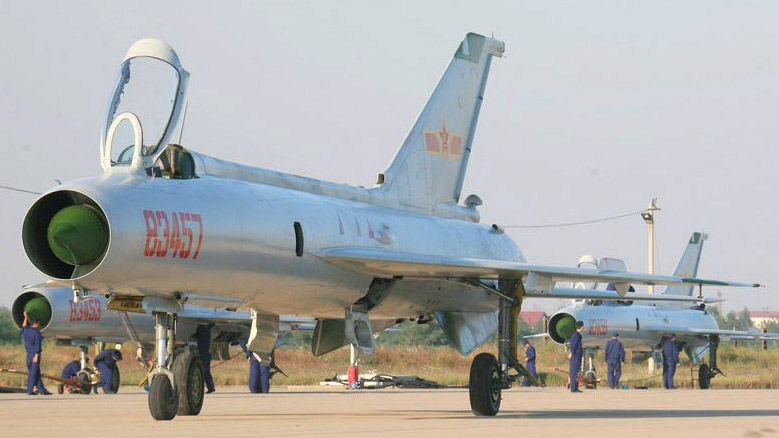
Although the J-8 more or less achieved the original design targets for performance, China’s inability to produce capable avionics and armaments gave the aircraft no distinctive advantage over the earlier J-7. Because of the slow progress in developing the fire-control radar and power unit, the basic variant J-8 was only fitted with a primitive ranging radar for day light, within visual range operations. The PLA originally planned to equip the J-8 fighter with a powerful 30 mm Type 30-II four-barrel Gatling gun with a rate of fire of 1,600 rounds/min. However, the development of the gun was trouble-prone and the aircraft was fitted with two 30 mm Type 30-1 cannons instead. Additionally, the PL-4 medium-range air-to-air missile (AAM) scheduled to be carried by the J-8 was also unsuccessful, leaving the fighter with only the PL-2 IR-homing short-range air-to-air missile (SRAAM) for air combat.
The basic variant J-8 was given a nickname ‘Finback-A’ by NATO. Only about 40 examples in this configuration were produced, and they only saw limited service with the PLAAF and PLANAF. Most of these have been converted for the photographic reconnaissance role.
J-8I
The Shenyang Aircraft Factory began to develop an improved all-weather variant known as J-8I (also referred to as J-8A) in 1976. The design work was completed in February 1978. The first prototype was completed in May 1980, but was destroyed in a fire accident. The development was delayed by a year while Shenyang build a new prototype. The second prototype made its first flight on 24 April 1982, followed by the flight of the third prototype in October. The aircraft was certified for designation finalisation in July 1985 after completing its flight testing.
The J-8I is generally identical to the basic variant J-8 in aerodynamic design and engine, but featured 11 improvements in avionics, including the Type 204 (JL-7) mono-pulse fire-control radar, SM-8A aeronautical optical gun-sight, onboard computer, new cockpit panel, and redesign ejection escape system and oxygen supply system. The J-8I can be distinguished from the basic variant J-8 by its three-piece front windscreen and rear-hinged canopy. The original two Type 30-I 30-mm cannons were replaced by two Type 23-III 23-mm cannons. The four under-wing stores stations were capable of carrying the PL-2B or PL-5 SRAAM.
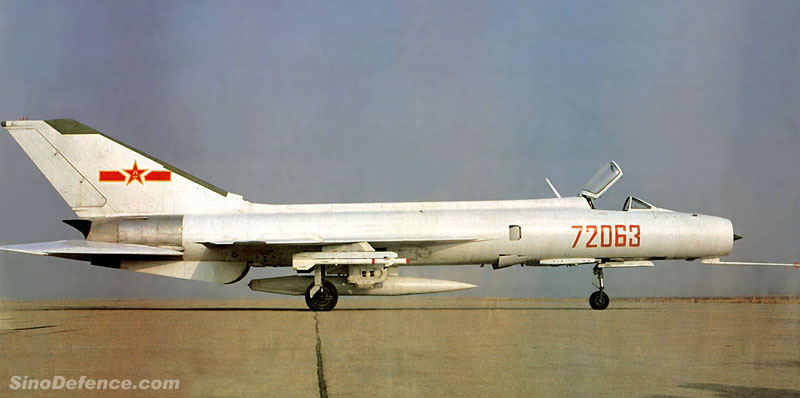
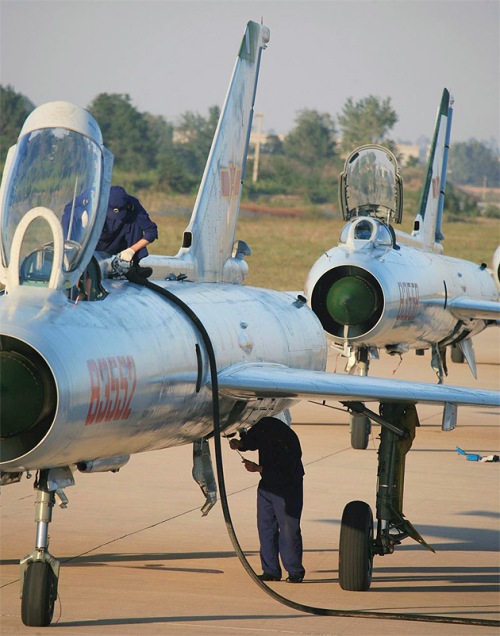
Only a small number of the J-8I was produced before its production stopped in 1987. The fighter has been deployed by both PLAAF and PLANAF for interception role. Some J-8I fighters were upgraded to the J-8E standard in the late 1990s.
J-8E
The J-8Is in service with the PLA received a mid-life modernisation upgrade in the late 1990s. The upgraded aircraft was re-designated as J-8E. Improvements included a new electronic countermeasures (ECM) suite featuring the KJ-8602A all-aspect radar warning receiver (RWR).
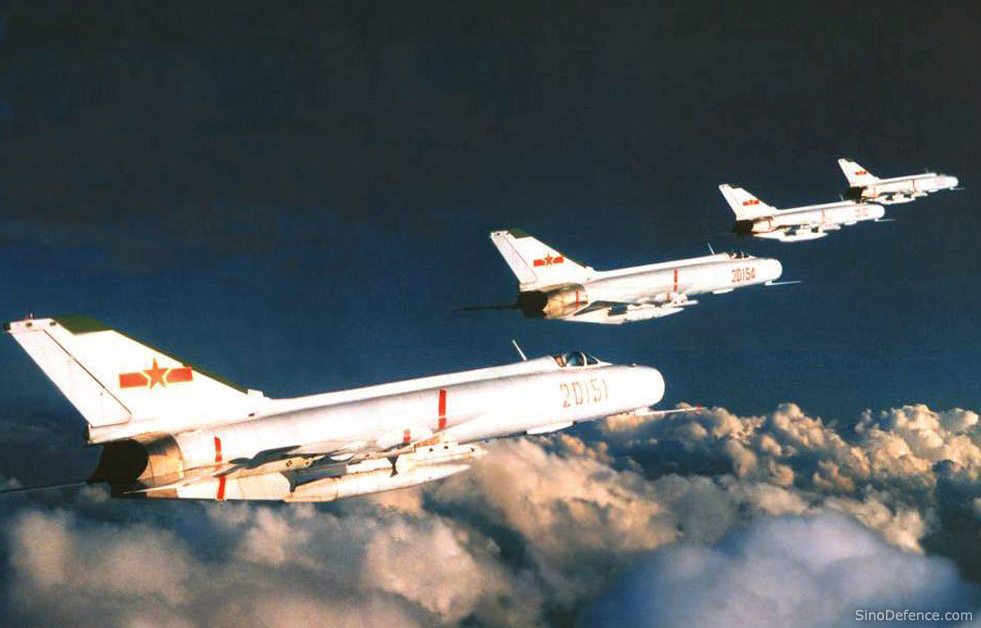
J-8I ACT Demonstrator
A J-8I fighter was converted into the active control technology (ACT) demonstrator aircraft for the testing of the indigenous fly-by-wire (FBW) system in the late 1980s. The first Chinese indigenous analogue FBW system was first successfully tested on the aircraft on 28 January 1989. A digital FBW system was successfully tested on the aircraft on 24 June 1990. The only example was lost in a flight accident on 23 April 1991.
JZ-8 Reconnaissance Variant
The JZ-8 (JianZhen-8) was introduced in the mid-1980s as a high-altitude, high-speed aerial platform for the tactical reconnaissance role. All examples are believed to have been converted from existing J-8 fighter airframes. With all armaments removed, the JZ-8 carried an under-fuselage reconnaissance pod containing an optical camera and two drop tanks under the wings. The JZ-8 was identical to the J-8, but could be identified by their four-digit serial numbers (fighter aircraft in service with the PLA all have five-digit serial numbers). Two regiments of the JZ-8 existed within the PLAAF order of battle. One of the regiments (with series number 35X3) was based in northeast China, close to borders with Russia, Korea, and Japan, with a second regiment possibly stationed near the Taiwan Strait.
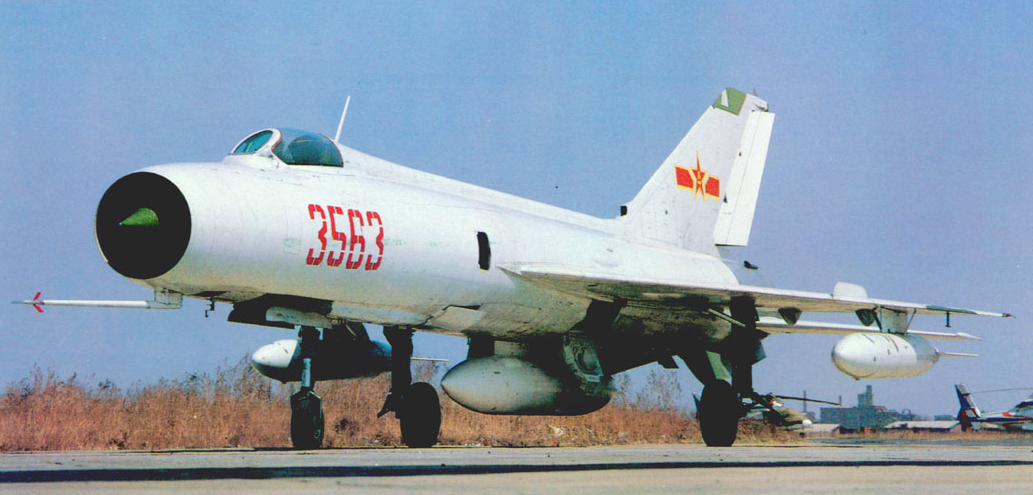
The KA-112A long focal-length optical camera took photos through two windows on the reconnaissance pod. The photos are taken in oblique panoramic mode on a 610 m (550 frames) film. Photo coverage was 3.5° longitudinal and 30° transversal. With two 480 litres drop tanks carried under the wings, the JZ-8 had a maximum ferry range of 2,000 km. Its typical operational altitude was between 9,500 and 15,000 m.
J-8II ‘Finback-B’
As the J-8I could not meet the PLA’s requirements, Shenyang began to develop a radically improved variant of the aircraft in the early 1980s. Rather than simply pursuing high-speed, high-altitude performance, the new fighter was required have decent aerodynamic performance at transonic speeds and medium-low altitudes. The PLA also demanded the ‘beyond-visual-range’ (BVR) air combat capability using the radar-homing MRAAMs, and ground attack as a secondary capability.
In order to meet these requirements, Shenyang introduced some extensive changes to the airframe and systems. While the delta wing remained unchanged, the forward fuselage was completely redesigned, with the original nose air inlet replaced by two lateral air intakes to allow a ‘solid’ nose in order to accommodate a larger size radar antenna. The underpowered WP-7 turbojet engines were replaced by the new WP-13AII. The fighter was also proposed to be fitted with a new fire-control radar with extended range and interception fire-control computer input and an autopilot for all-weather operations.
The new improved fighter, designated J-8II, entered full-scale development in September 1980. The first J-8II prototype was completed in March 1984 and flew for the first time on 12 June. The aircraft was certified for design finalisation in October 1988 after completing its flight testing.

Compared to its predecessor, the J-8II achieved modest improvement in manoeuvrability. Test results showed that the J-8II’s intake efficiency was the same as the J-8 at high speeds and 6% higher at lower speeds. An electrically-controlled differential horizontal tail plane resulted in the J-8II being 45% more efficient in roll control at subsonic speeds compared with the J-8.
The pre-production variant J-8II was equipped with an indigenous Type 208 mono-pulse fire-control radar with a detection range of only 40 km. Due to the lack of an operational radar-homing MRAAM, the J-8II initially could only carry the IR-homing SRAAM for visual range combat. Fixed weapon on the J-8II included a twin-barrel Type 23-III (a copy of the Gryazev-Shipunov GSh-23L) 23-mm cannon with 200 rounds in a ventral installation. The aircraft has seven hard points (one under fuselage and six under wings). The centreline fuselage hard point had a GDJ-4 pylon integrated dispenser system, which can carry up to six 250-kg low-drag free-fall bombs, or a 1,400-litre drop tank. The under-wing hard points could carry up to six air-to-air missiles, or unguided rocket launchers, or 250-kg free-fall bombs. The two outboard wing hard points were also pumped to carry 800-litre drop tanks.
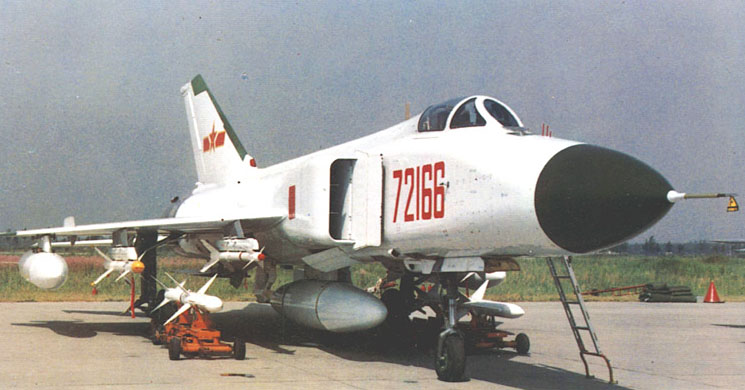
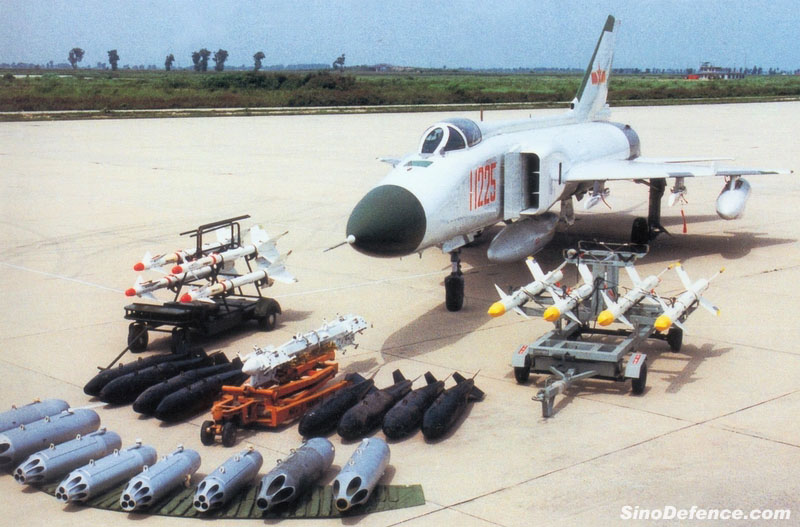
Peace Pearl Project
In 1986 the Regan administration approved the ‘Peace Pearl’ Sino-U.S. cooperation project to help China to modernise its J-8II fighter, with the aim to jointly counter the threat of the Soviet Union. Under the agreement, American company Grumman would supply the U.S.-made avionics worth US$502 million to upgrade 55 J-8II fighters. The modernisation packge included the Westinghouse AN/APG-66(V) radar, 1553B MIL-STD data bus, fire-control computer, head-up display (HUD), cockpit multifunctional displays (MFD), navigation system, and ejection seat.
In early 1989, Shenyang delivered two J-8II fighters to the U.S. for modernisation refit and tests. The aircraft were flown by the U.S. Air Force Test Centre at the Edwards Air Force Base. However, the project was cancelled as a result of the arms embargo imposed on China by the US in the aftermath of the 1989 Tiananmen Square incident.
J-8II ACT Demonstrator
The J-8II ACT (Active Control Technology) demonstrator was introduced in the 1990s for studying and testing the ‘fly-by-wire’ (FBW) technology. The aircraft was based on the J-8II airframe, with a shorter fuselage and a pair of front canards being added to the front fuselage just behind the air inlets. The J-8II ACT replaced the older FBW demonstrators based on the JJ-6 (known as BW-1) and J-8 (known as J-8 ACT). The J-8II ACT played an important role in developing the FBW technology for China’s fourth-generation fighters such as the J-10 and JH-7.
J-8B
The J-8II Block-02, also known as J-8B, was the first operational variant of the J-8II. Making first flight in November 1989, the J-8B featured a number of improvements in avionics, including the Type 208A mono-pulse fire-control radar, HK-13E head-up display, Type 563B integrated INS/GPS, and JD-3II TACAN. Later production variant was also fitted with the KLJ-1 pulse-Doppler fire-control radar and KJ-8602A all-aspect radar warning receiver (RWR). Despite these improvements, the J-8B still lacked the BVR combat capability due to its incapable fire-control radar. The aircraft was certified for design finalisation in December 1995 and entered service with the PLAAF and PLANAF thereafter.
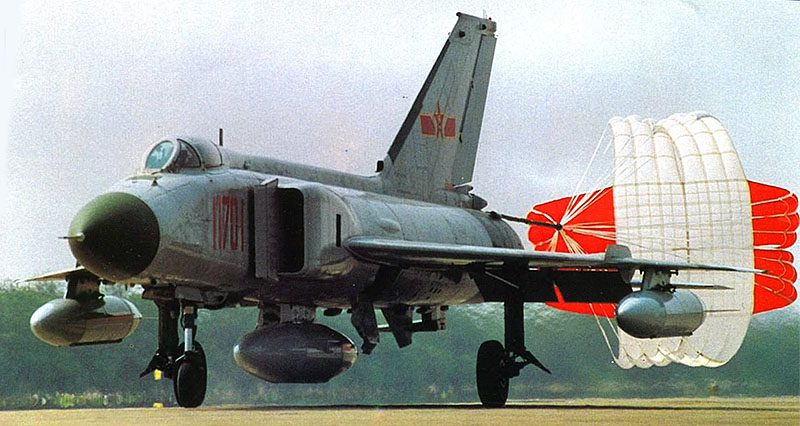

J-8III
Following the cancellation of the “Peace Pearl” modernisation upgrade project, Shenyang continued its own modernisation programme for the J-8II, possibly under the assistance of Israel or Russia. In the early 1990s, a radically upgraded variant J-8C (also known as J-8III) was introduced featuring new avionics and power plant, which could eventually bring the fighter into the same league as modern Russian and Western fighters such as MiG-29 and Mirage 2000-5. The J-8C programme entered development around 1991 and the aircraft first flew successfully in 1993.
The C model featured a number of improvements including a new multi-mode pulse Doppler radar which was reportedly based on the Israeli Elta EL/M 2035 technology, a digital fire-control system, and a new ‘glass’ cockpit with multifunctional displays (MFD). The aircraft’s original WP-13AII turbojet engine was replaced by the more powerful WP-14 turbojet then being developed by the Shenyang Liming Aero-Engine Company.
A total of two J-8C prototypes were identified, carrying serial number ‘8301’ and ‘551’. Prototype ‘551’ was also fitted with an in-flight refuelling probe. The J-8C development was cancelled in the late 1990s by the PLAAF in favour of the more capable Su-27/J-11 fighter. Its technologies were late used on the development of the J-8F variant.
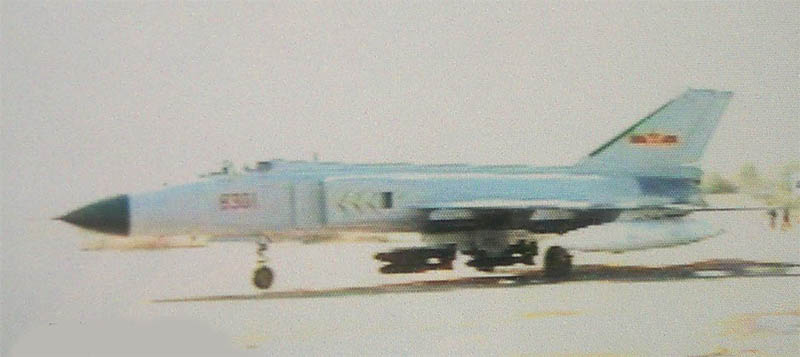
J-8D
Shenyang began to study the feasibility of adding the J-8II fighter with in-flight refuelling capability in the late 1980s. A modified J-8II with a fixed refuelling probe first flew on 21 November 1990. The first successful in-flight refuelling from a H-6 tanker possibly took place in 1992/93. The aircraft entered the PLAAF and PLA Naval Aviation service in 1996 under the designation J-8D, and made its first public debut on 1 October 1999 during the flypast in Beijing to celebrate the 50th anniversary of the People’s Republic of China.
The J-8D has a fixed, non-retractable refuelling probe installed on the starboard side of the cockpit. Chinese newspaper reported that the early J-8D design suffered from high volume of noise caused by the air passing around the fixed refuelling probe in high-speed flight, causing serious disruption to the pilot inside the cockpit. The problem was solved later by modifying the probe design.
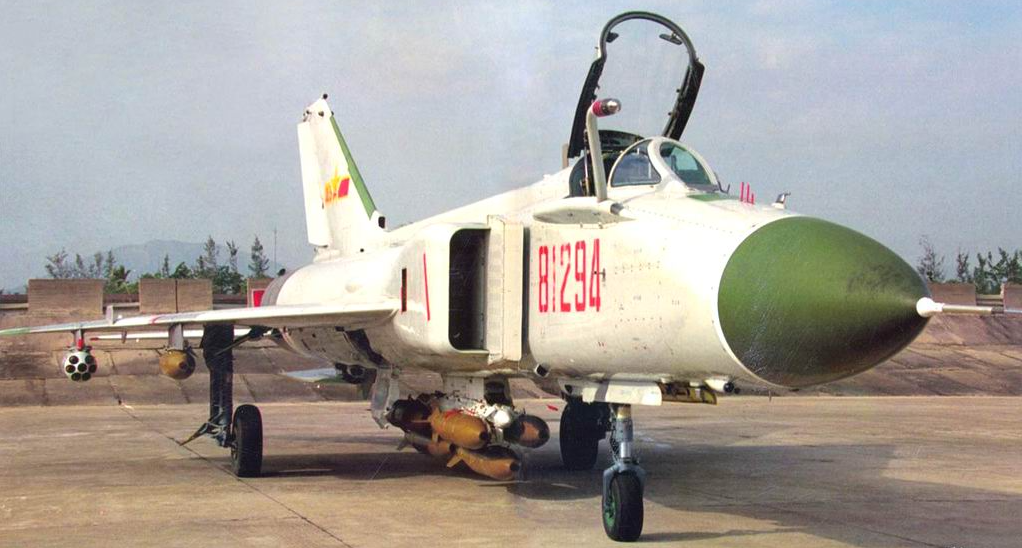

Apart from its refuelling probe, the J-8D appeared to be identical to the J-8B in avionics and weapon configuration. The aircraft was deployed in limited numbers by both the PLAAF and PLANAF. With one refuelling, the aircraft’s combat radius can be extended from 800 km to 1,200 km, enabling it to reach the remote islands in the South China Sea.
F-8IIM
The rapidly improving Sino-Russia relations in the early 1990s presented an opportunity for Shenyang to upgrade the J-8II with Russian technologies. This led to the introduction of the F-8IIM, a multirole fighter fitted with Russian-made radar and weapons. The first F-8IIM prototype built from the J-8II prototype ’57’ first flew on 31 March 1996. The aircraft made its debut during the first Zhuhai Air Show in November of the same year.
Key improvements on the aircraft included:
- Russian Phazotron Zhuk-8II coherent pulse-Doppler fire-control radar (X-band)
- Type 563B integrated INS/GPS navigation system
- Coloured multifunction display in the cockpit
- New fire-control system with MIL-STD-1553B data bus and MIL-STD-1760A weapon bus
- New electronic countermeasures suite (with active jamming and all-aspect RWR)
- Type 125 IFF
- Two Russian-made PGD-40-2K 15kW alternators
- Two improved WP-13B turbojet engine each rated at 4,800 kg dry and 7,000 kg with afterburning
The X-band Phazotron Zhuk-8II coherent pulse-Doppler fire-control radar had a maximum detecting range of 75 km against airborne targets and 100 km against sea surface targets. When in the air-to-air mode, the radar can track up to 10 airborne targets and attack 2 of them simultaneously. With its 14 operating modes, the radar can guide a range of air-to-air and air-to-ground weapons including the R-27R1 (AA-10 ‘Alamo-A’) semi-active radar-homing MRAAM and the Kh-31A (AS-17 ‘Krypton-A’) supersonic anti-ship missile.
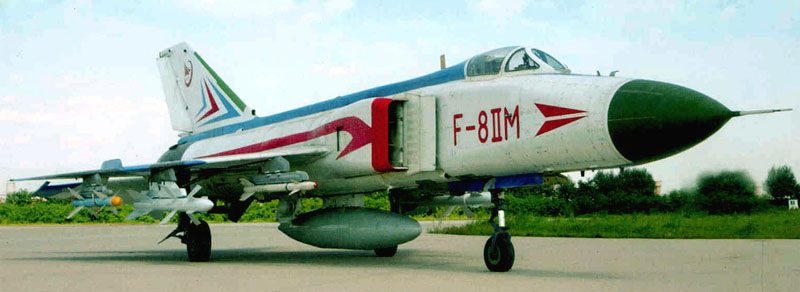
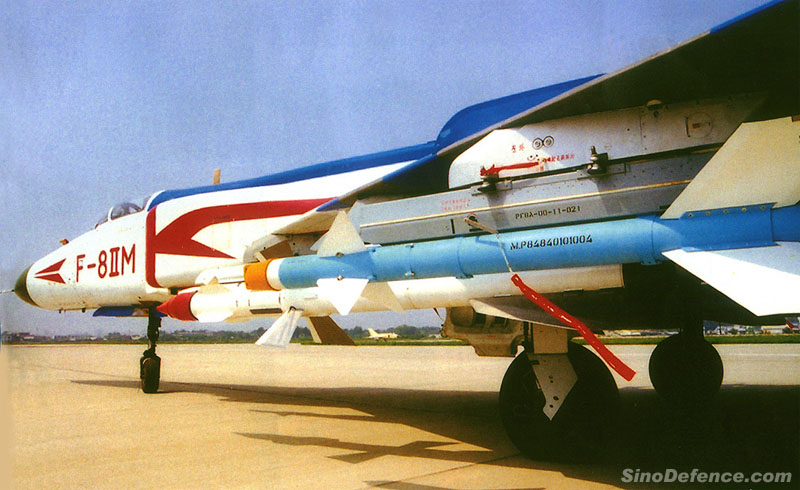
In 2004, Shenyang introduced a revised F-8IIM design featuring purely Chinese developed avionics, possibly based on the technology of the J-8F. The new 2004 version F-8IIM was fitted with an indigenous JL-10A (or Type 1492) pulse-Doppler fire-control radar with both air-to-air and enhanced air-to-surface capabilities. As well as the R-27R1 and Kh-31A, the aircraft was also capable of firing the Chinese indigenous PL-12 (SD-10) active radar-homing ‘fire-and-forget’ MRAAM and laser guided bombs.
The F-8IIM project was entirely funded by Shenyang with no PLA funding. The company hoped to target primarily third-world customers seeking a low-cost, relatively high-performance fighter to replace their ageing Cold Ear-era designs. However, the aircraft failed to attract any foreign or domestic buyer, possibly due to the complexity in aircraft maintenance involving both Chinese and Russian manufacturers, and also partially due to the competition of Russian fourth-generation fighters such as the Su-27 and MiG-29 in the international market.
J-8F
The J-8F introduced by Shenyang in the early 2000s was the ultimate final mature variant of the J-8II family. With a new X-band fire-control radar (Type 1492), the PL-12 active radar-homing MRAAM, secondary air-to-surface/ship strike capability, ‘glass’ cockpit, in-flight refuelling probe, and more powerful WP-13BII turbojets (each rated at 7,000 kg with afterburning), the J-8F finally met all requirements set by the Chinese military when the aircraft development first began almost two decades before.
The J-8F is generally similar to previous models of the J-8II family in appearance. The most recognisable features are two wing fences on each wing (in contrast to one on previous models) and the stiffened nose radome. The new fire-control radar has a radio command transmitter to provide mid-course correction for the PL-12 MRAAM during the ‘beyond-visual-range’ (BVR) attack. If necessary, the radar could also guide Russian-made missiles such as the R-27 (AA-10) and R-77 (AA-12). The radar also has enhanced air-to-ground and air-to-sea modes to fire a range of precision guided (laser/radar/satellite) munitions and anti-ship missiles.
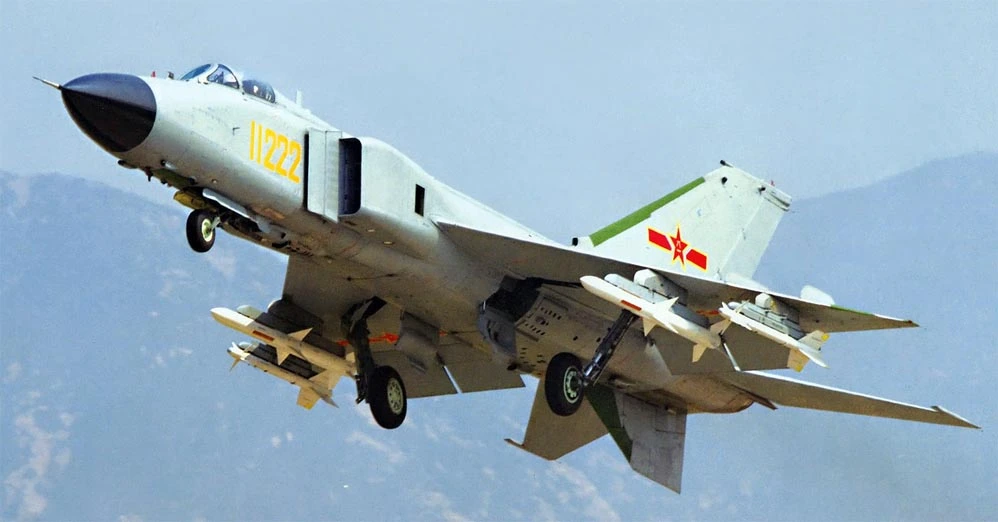

Although the J-8F has yet approached the capabilities of advanced fighter aircraft such as Su-27 or Su-30, it provides a relatively inexpensive solution to augment the PLAAF’s fourth-generation fighter fleet. The aircraft first flew in 2000 and the first successful test fire of the PL-12 MRAAM took place in spring 2004. The fighter entered PLAAF service in 2003.
JZ-8F Reconnaissance Aircraft
The JZ-8F is a reconnaissance variant based on the J-8F airframe. The aircraft features an internal camera compartment replacing the twin-23 mm cannon. With a small and a large window, the compartment possibly accommodates both day-light and night-vision cameras.

J-8H
The J-8H was introduced in 1999 as a stopgap before the more capable J-8F variant could enter service. The aircraft features a KLJ-1 (Type 1491) pulse-Doppler fire-control radar with ‘look-down/shoot-down’ capability and ability to fire the PL-11 semi-active radar-homing MRAAM. Other improvements include modernised cockpit avionics, two wing fences on each wing (similar to those of the J-8F) for better aerodynamic performance and the stiffened nose radome. The H model has been serving with the PLAAF in a limited number since 2002, and may have now been upgraded to the J-8F standard.
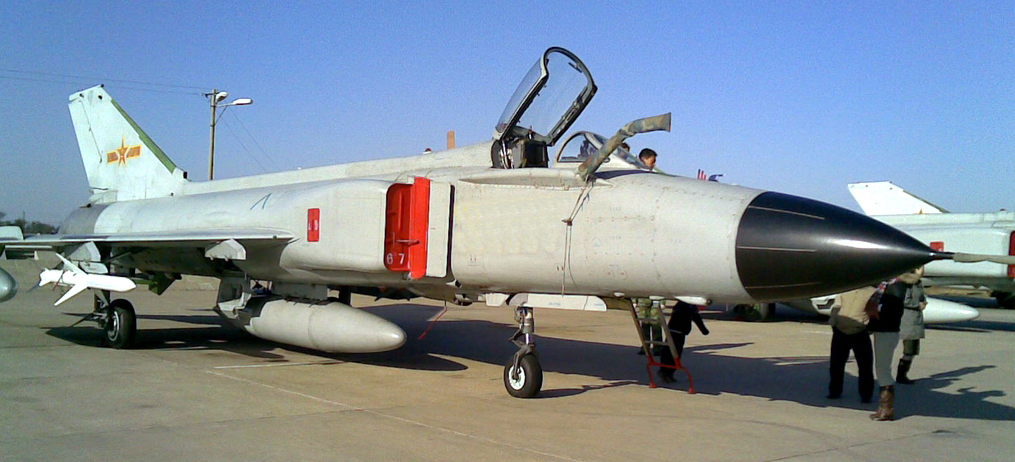
Conclusion
The J-8 was China’s first successful attempt to develop a fighter independently. At the time of its introduction in the 1980s, the aircraft represented the highest technological achievement in China’s aviation industry. By the time the design finally matured in the early 2000s, the PLA had already fielded more capable fourth-generation fighters such as the Su-27/30/J-11 and the J-10. The evolution of the J-8 fighter family was a reflection of the progress that had been made in China’s technological and industrial capability over the past four decades.
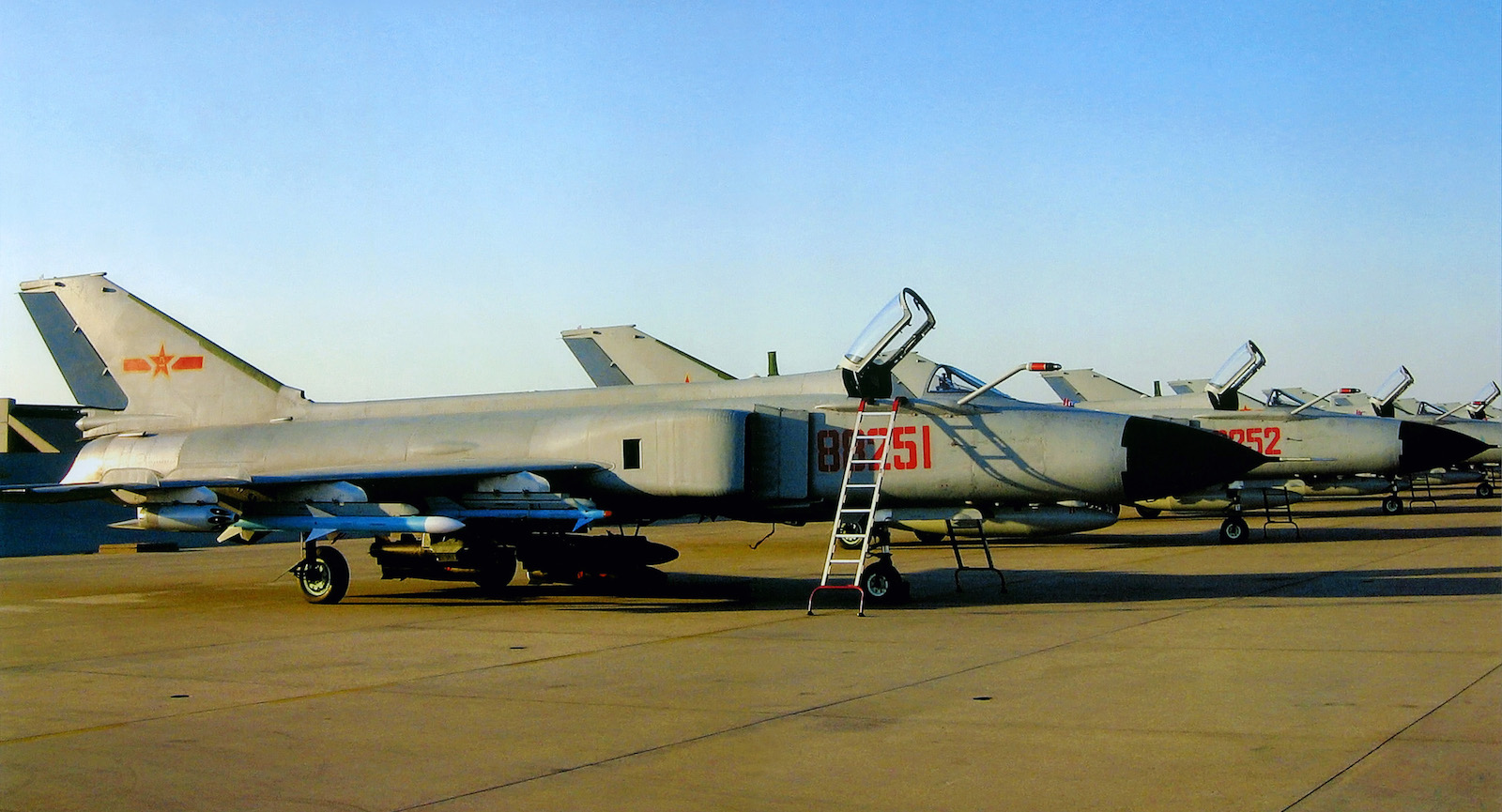
What’s up,I check your new stuff named “Shenyang J-8 fighter: A history of evolution – SinoDefence” daily.Your story-telling style is witty, keep it up! And you can look our website about تحميل اغانى.